Table of Contents
- Introduction
- Editor’s Choice
- Cybersecurity and Data Protection
- Cybersecurity Statistics by Attack Type
- Privacy Concerns By Digital Trust Statistics
- Cybersecurity Incidents According to Industry
- Digital Trust Issues Related to the Government Statistics
- Organizations Digital Trust Risks Mitigated Statistics
- Digital Trust Index of Different Nations Statistics
- Recent Developments
- Conclusion
- FAQs
Introduction
Digital Trust Statistics: Digital trust is the bedrock of assurance concerning security, and privacy. Further dependability of digital systems, services, and data, underpinning the triumph of online commerce, safeguarding information, technological progress, and cybersecurity.
It plays a fundamental role in an era marked by data breaches. It is concerned about privacy and the reception of emerging technologies such as AI and blockchain.
The fundamental elements of digital trust encompass aspects like security, privacy, openness, dependability, user experience, reputation, and adherence to legal and ethical principles.
All of these are pivotal for nurturing trust in our swiftly evolving digital environment. Trust is indispensable for our internet interactions and transactions, exerting a critical influence on social, economic, and political consequences.
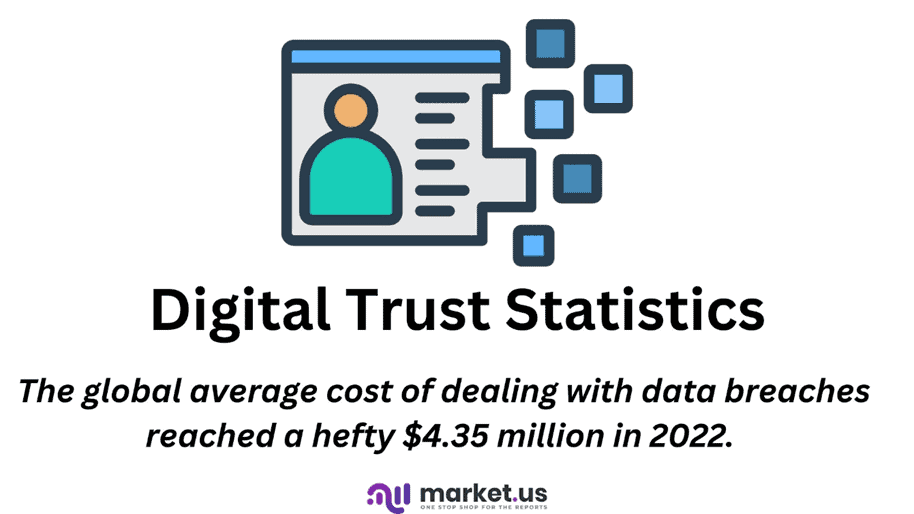
Editor’s Choice
- Digital Transformation Market was valued at USD 535 billion and is expected to reach USD 3375 billion in 2032
- Phishing became the most prevalent cyber threat, bombarding inboxes with approximately 3.4 billion spam emails daily.
- The global average cost of dealing with data breaches reached a hefty $4.35 million in 2022. Breaches resulting from compromised or stolen login credentials carried an average price tag of $4.50 million.
- In 2022, ransomware attacks took a toll on 71% of businesses.
- Phishing emerged as the most prevalent, impacting a staggering 300,497 victims.
- The banking and financial sector emerged as the most trusted. With 42% of consumers expressing confidence in digital services within this industry.
- According to McKinsey’s analysis, banks have the potential to achieve cost savings ranging from 20% to 25% by transitioning to digital operations.
- Roughly 34% of Gen Z shoppers are highly skeptical towards most online stores.
- During the first half of 2022, the United States topped the list with a staggering 72,718 requests. Showcasing the significant demand for user information.
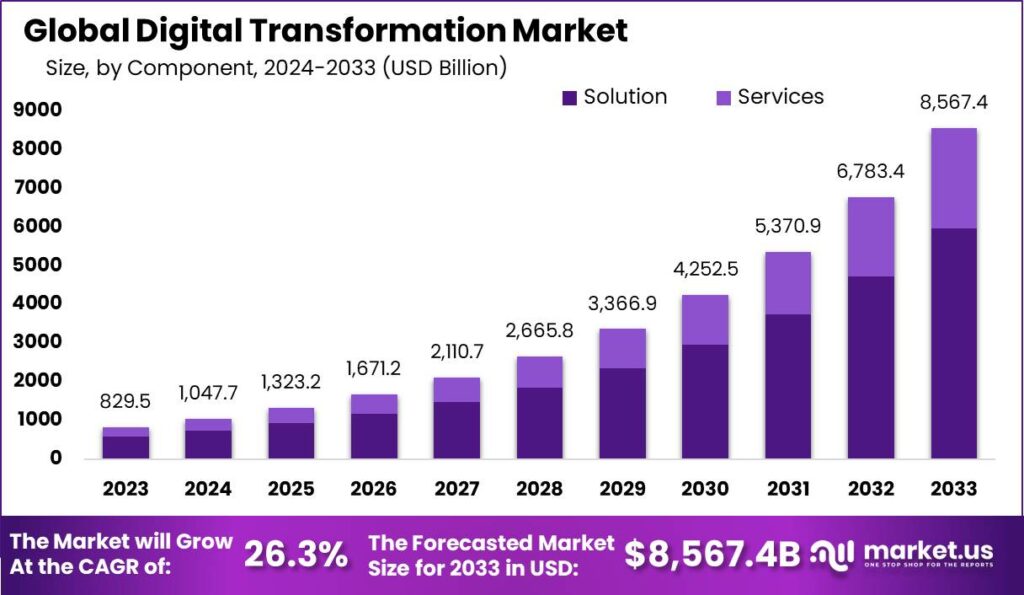
Cybersecurity and Data Protection
Data Breaches by Digital Trust Statistics
- In 2022, organizations worldwide faced a staggering 493.33 million ransomware attacks.
- Phishing became the most prevalent cyber threat, bombarding inboxes with approximately 3.4 billion spam emails daily.
- The global average cost of dealing with data breaches reached a hefty $4.35 million during that year. Breaches resulting from compromised or stolen login credentials carried an average price tag of $4.50 million.
- Unfortunately, the healthcare industry has held the unenviable title of experiencing the costliest breaches for a dozen years. With the average expense of a data breach in this sector spiking to $10.10 million in 2022.
- In 2022, ransomware attacks took a toll on 71% of businesses.
- Right now, one of the riskiest spots for cyberattacks is the cross-chain bridges. With breaches costing a whopping $2 billion this year.
- Alarmingly, North Korean hackers managed to make off with nearly $1 billion worth of cryptocurrencies in 2022 alone.
- The first half of 2022 saw a jaw-dropping 1.51 billion reported IoT breaches. Underscoring the immense challenge that organizations are grappling with.
(Source: Tecopedia, Astra)
Cybersecurity Statistics by Attack Type
- The FBI’s Internet Crime Report for 2022 reveals a comprehensive breakdown of cybercrime statistics by attack type, underscoring the diverse range of threats faced in the digital realm.
- Phishing emerged as the most prevalent, impacting a staggering 300,497 victims.
- Personal Data Breaches affected 58,859 individuals, while Non-Payment/Non-Delivery scams impacted 51,679.
- Extortion schemes preyed on 39,416 victims, while Tech Support scams affected 32,538.
- Investment fraud lured 30,529 victims, followed closely by Identity Theft at 27,922.
- Credit Card/Check Fraud impacted 22,985 individuals, and Business Email Compromise (BEC) schemes targeted 21,832 victims.
- Additionally, Spoofing tactics impacted 20,649 victims, illustrating the extensive variety of cybercrimes plaguing individuals and organizations.
(Source: FBI’s Internet Crime Report for 2022)
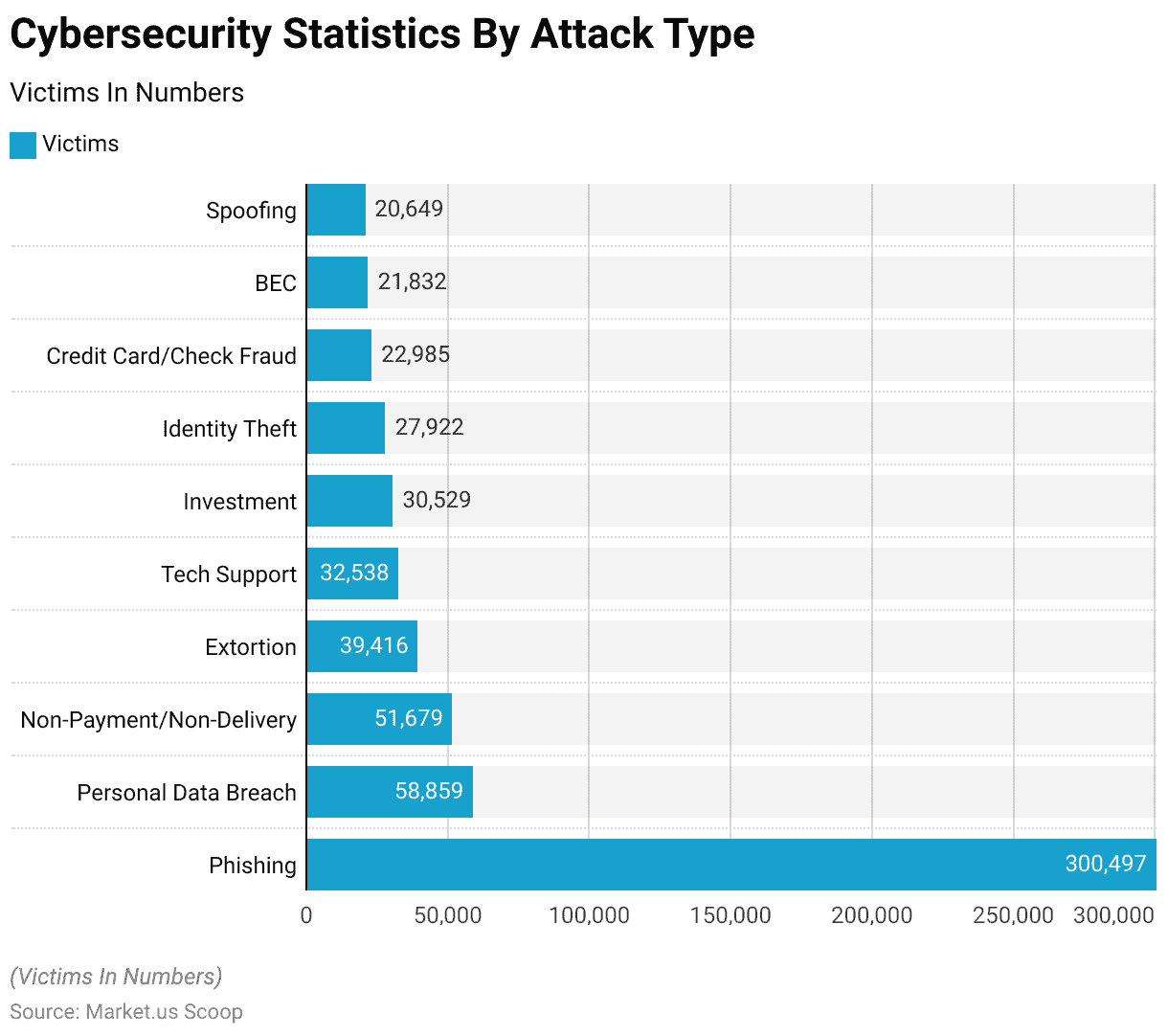
Privacy Concerns By Digital Trust Statistics
- A recent report from PwC drives home a concerning reality for businesses: 85% of customers now hesitate to engage with a company if they have doubts about its data practices, highlighting the growing importance of proactive security measures.
- The survey findings mirror a broader trend where consumer trust in businesses appears to be eroding.
- Shockingly, only 12% of those surveyed stated that they trust companies more than they did a year ago, with a mere 17% indicating more trust than a decade ago.
- This leaves a substantial majority who gradually lose faith in the companies they deal with.
- Even more telling is that 88% of respondents link their willingness to share personal data directly to their trust in a company, and 87% are ready to take their business elsewhere if that trust is shaken.
- Since just a quarter of the participants believe companies handle their data securely, many potential customers might be slipping away.
- While some people are open to sharing their data in exchange for something they perceive as valuable, a mere 15% believe that companies are using their data to enhance their lives, tipping the scales unfavorably in the customer’s view.
(Source: PwC)
Take advantage of our unbeatable offer - buy now!

Cybersecurity Incidents According to Industry
- As per a report from the US Homeland Security, a breakdown of cybersecurity incidents by sector reveals some interesting insights.
- The energy sector tops the list, accounting for 32% of these incidents, highlighting the critical need for security in this industry.
- Following closely, the critical manufacturing sector experienced 27% of these incidents, underscoring the vulnerabilities within manufacturing processes.
- The communications, water, healthcare, and government facilities sectors accounted for 6% of the incidents, indicating that no sector is immune to cybersecurity challenges.
- The transportation and commercial facilities sectors each faced 5% of these incidents, while information technology, nuclear, and other/unknown sectors each reported 2% of the incidents.
- These statistics shed light on varying vulnerabilities across different sectors and emphasize the need for comprehensive cybersecurity measures in an increasingly digital world.
(Source: US Homeland Security Report)
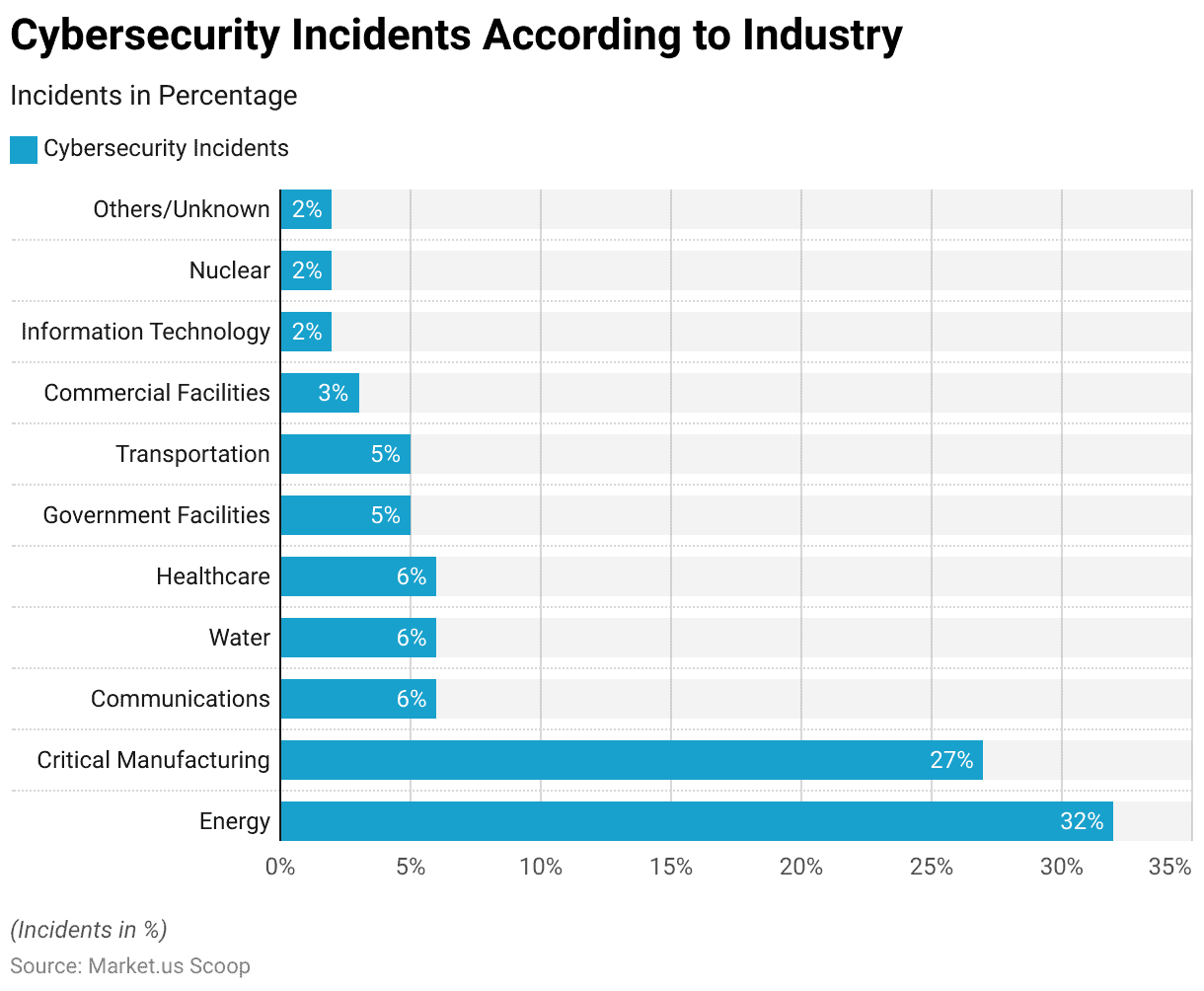
Consumer Trust in Digital Services Statistics
- In 2022, global consumer trust in digital services showed a notable variation across different industries.
- The banking and financial sector emerged as the most trusted. With 42% of consumers expressing confidence in digital services within this industry.
- Healthcare providers followed closely, with 37% of consumers trusting digital healthcare services.
- However, consumer technology providers saw a slightly lower level of trust at 32%, indicating a moderate confidence level.
- In contrast, social media companies faced a significant challenge in gaining consumer trust. With only 18% expressing confidence in their digital services.
- Government services saw a trust rate of 14%. At the same time, the media and entertainment industry had the lowest trust level. With a mere 12% of consumers placing their faith in digital services within this sector.
- These statistics reflect the varying degrees of trust across industries, underlining the importance of trust-building efforts in the digital realm.
(Source: Statista)
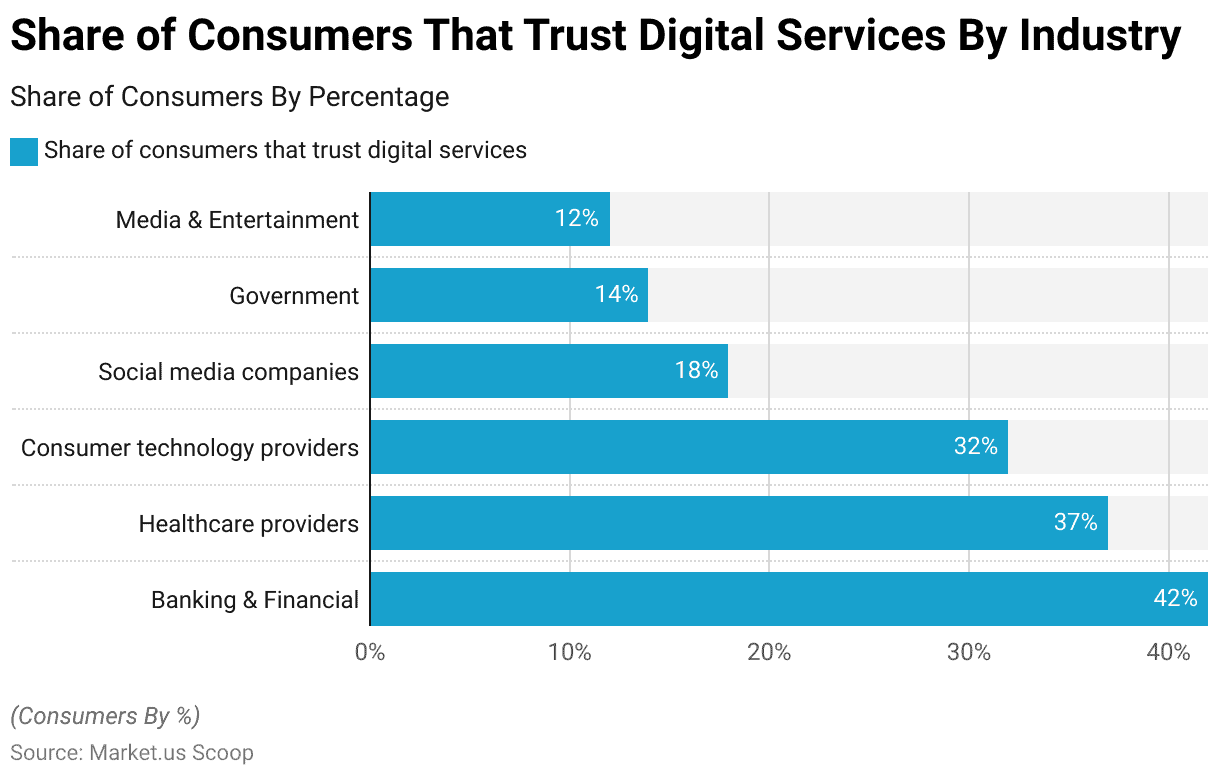
Online Banking By Digital Trust Statistics
- In a July 2020 survey conducted by Lightico with 1,329 Americans. It was observed that individuals with higher incomes tend to view financial transactions as a matter of significant sensitivity.
- Among banking customers, 55% indicated they would reduce their visits to the bank branch.
- An additional 26% intended to avoid in-person banking interactions.
- In contrast, 10% expressed their intent to increase their visits to the bank branch compared to their current frequency.
- Notably, banks have strong motives to encourage their customers to use more extensive digital services.
- According to McKinsey’s analysis, banks have the potential to achieve cost savings ranging from 20% to 25% by transitioning to digital operations.
- This shift saves time and enables agents to channel their efforts toward delivering enhanced customer service rather than handling physical paperwork.
- Individuals with higher incomes earn above $76,000 annually. Showed a notably stronger inclination to consider financial transactions more sensitive than other online dealings.
- A substantial 70% of this group rated financial transactions as the most sensitive, compared to only 51% of the lowest-income earners who shared a similar perspective.
- Intriguing patterns emerge when examining trust levels in online financial transactions based on income categories.
- Individuals with incomes below $49,000 exhibited a trust level of 67%.
- In the income bracket of $50,000 to $75,000, the trust level was slightly higher at 68%.
- Notably, those with higher incomes exceeding $76,000 displayed the highest trust level at 74%.
- These statistics suggest a correlation between income and trust in online financial transactions. With higher-income earners demonstrating greater confidence in digital financial dealings.
(Source: McKinsey, Lightico)
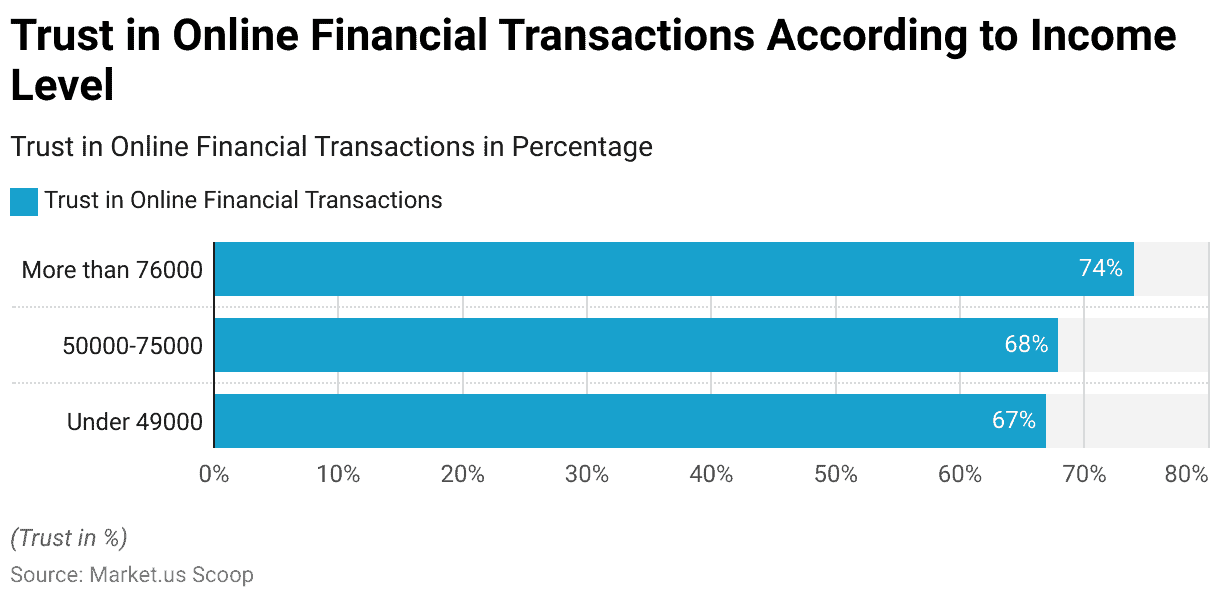
Social Media Trust
- A recent study conducted by UNICEF in collaboration with Gallup highlights that today’s individuals between the ages of 15 and 24 rely on social media and various online sources to stay informed about current events.
- However, it’s important to note that this reliance doesn’t necessarily translate into trust in the information they receive from these sources.
- In a survey encompassing 21 countries with varying income levels, young people in the 15-24 age group reported that they primarily use social media or online news sites to stay updated, with 45% indicating social media as their primary source and another 14% favoring online news sites.
- In contrast, older generations in these countries tend to turn to television, radio, and newspapers for their current affairs updates.
- What’s notable is that only 17% of young adults express a high level of trust in social media platforms, indicating that they are twice as likely to place substantial trust in the accuracy of national (37%) and international media (36%) when compared to social media platforms.
(Source: Gallup)
Trust in E-commerce Platforms
- Roughly 34% of Gen Z shoppers are highly skeptical towards most online stores.
- Notably, many website visitors fail to recognize trust seals, including some of the top 10 security seals known by less than 10% of shoppers.
- What’s been noted is that a combination of contemporary website design and quality seals associated with products is pivotal in bolstering a website’s credibility.
- When these elements are used together, they can increase the number of individuals who perceive websites as dependable by approximately 30%.
- Conversely, an excessive reliance on prominent promotional banners and popups has the opposite effect, effectively doubling the number of customers who view a website as untrustworthy.
- Furthermore, over 67% of customers abandon their shopping endeavors mid-way when suspicions are raised.
- In open-ended queries, respondents consistently emphasized that information ranks among the most pivotal factors influencing trust.
- A study conducted by the Centre for International Governance Innovation revealed that nearly half, or 49%, of internet users, harbor concerns regarding the potential misuse of their private data by online stores, a concern significant enough to deter them from online shopping altogether.
- However, as per their findings, at first glance, they paint a somewhat brighter picture, with approximately 78% of survey participants expressing confidence in the trustworthiness of most online stores.
(Source: Tidio)
Trust in Online Reviews
- According to a survey conducted in October 2018, how people perceive and trust online reviews has evolved.
- In 2014, most didn’t always rely on reviews, with no “Yes, always” responses.
- However, by 2018, 19% of respondents claimed they always trusted online reviews.
- A notable shift occurred in the “Yes if I believe the reviews are authentic,” with 22% in 2014 and 31% in 2015, then a return to 19% by 2018.
- The attitude of “Yes, for some types of businesses, no for others” steadily declined from 34% in 2014 to 15% in 2018.
- “Yes, if there are multiple customer reviews to read,” experienced a minor increase from 26% in 2014 to 25% in 2018.
- In contrast, the skepticism towards online reviews grew, with 16% in 2018 stating they were often skeptical, while 6% claimed they didn’t trust reviews.
- This data illustrates a changing landscape in how consumers approach and rely on online reviews over this period.
(Source: Statista)
Digital Trust Issues Related to the Government Statistics
- During the first half of 2022, Google received numerous user data requests from federal agencies and governments across various countries.
- The United States topped the list with 72,718 requests, showcasing the significant demand for user information.
- India followed closely with 32,335 requests, reflecting the country’s growing digital presence and the government’s interest in data access.
- Germany and Brazil also demonstrated notable figures, with 25,668 and 11,515 requests, respectively.
- The United Kingdom, Poland, France, and Spain contributed to this trend with their respective figures of 9,853, 7,133, 6,125, and 4,912 requests.
- Other countries like South Korea, Australia, Italy, Ireland, and Switzerland also engaged in user data requests, highlighting the global nature of this data access phenomenon.
- This data underscores the critical importance of privacy and data protection in an increasingly interconnected world, with governments seeking access to user information for various reasons.
(Source: Statista)
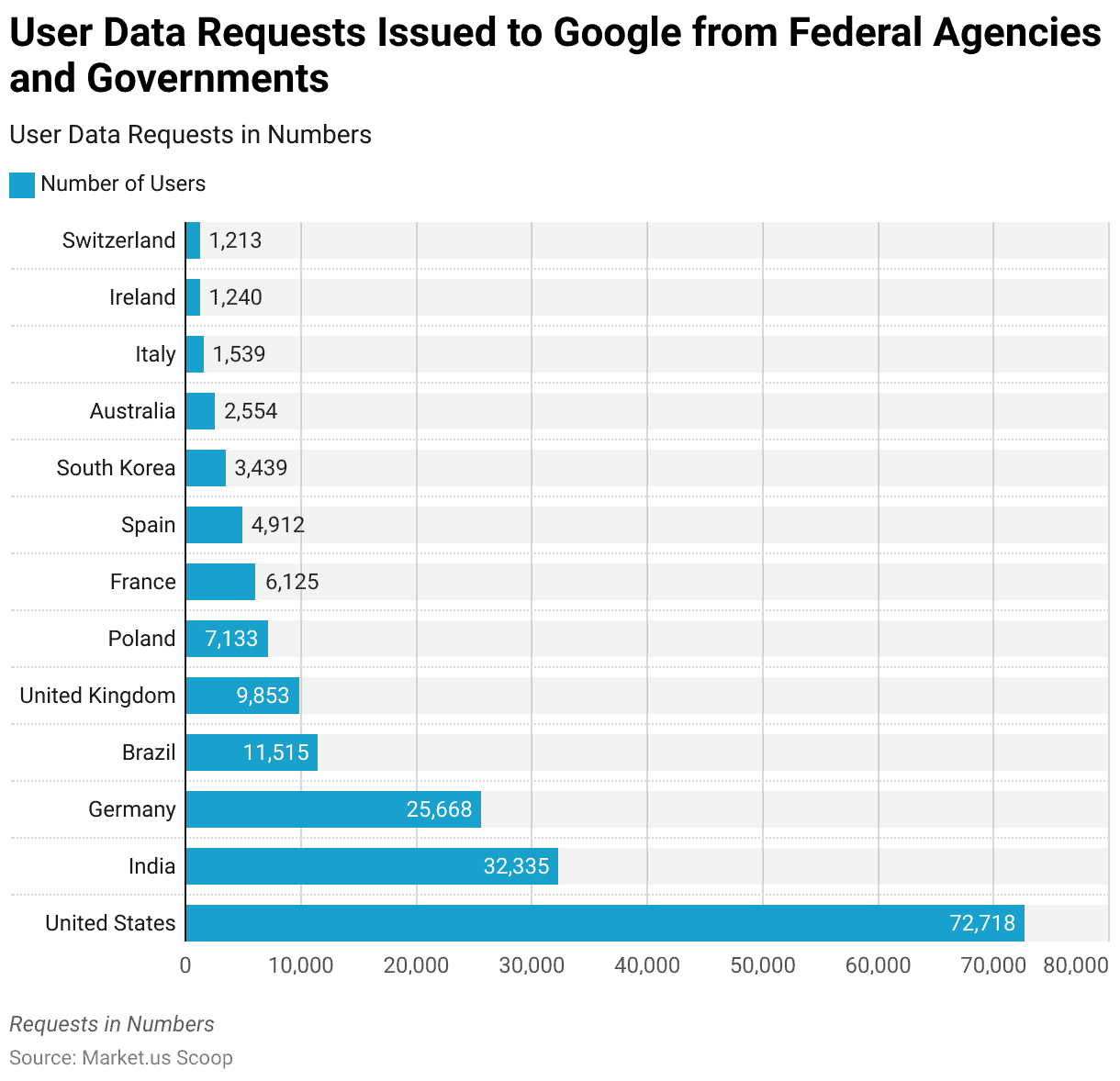
Organizations Digital Trust Risks Mitigated Statistics
- Organizations are actively addressing a spectrum of digital risks with various mitigation strategies.
- Cybersecurity remains a focal point, with efforts to mitigate these risks falling in the 33-41% range.
- Data privacy is another critical concern, and organizations are taking measures to manage these risks within the 23-31% range.
- Additionally, mitigating risks related to IT operations is a focus, with efforts spanning from 19-26%.
- Data quality concerns are managed with a commitment of 15-23%.
- Furthermore, organizations are paying attention to mitigating risks associated with cloud migration, targeting percentages between 14-20%.
- Cloud configuration risks are also being addressed, with efforts ranging from 13-18%.
- This data underscores organizations’ multi-faceted approach to managing and mitigating various digital risks effectively.
(Source: McKinsey)
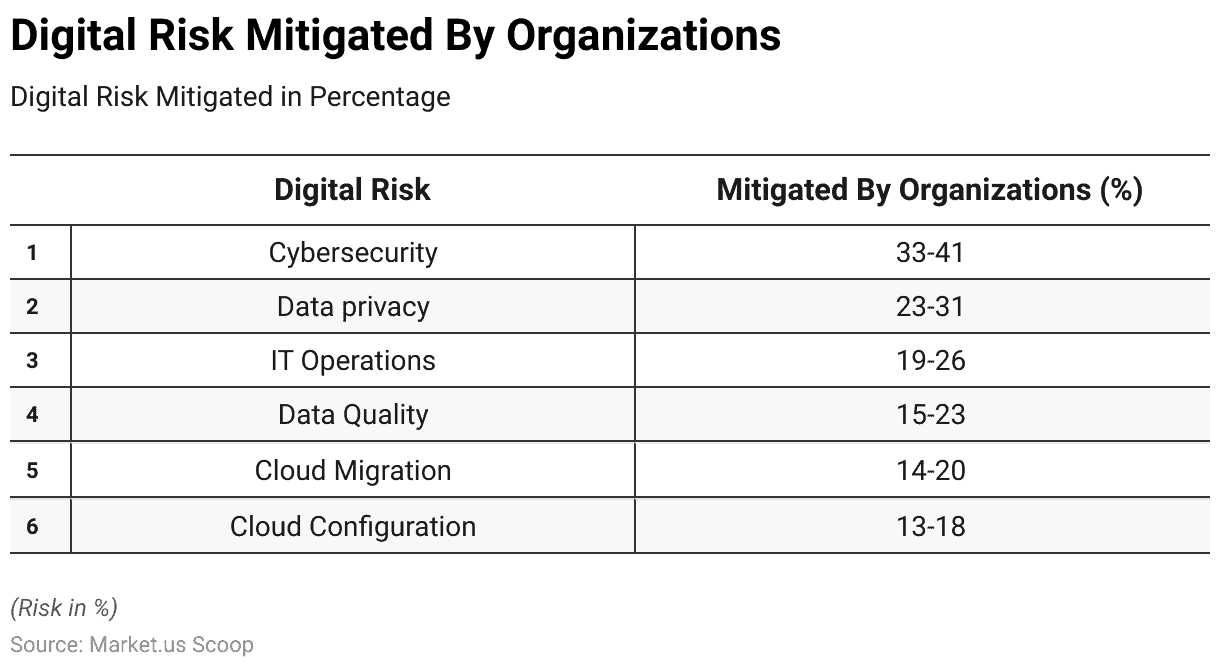
Digital Trust Index of Different Nations Statistics
- The Digital Trust Index, which measures trust in digital technologies and online platforms, was calculated for 42 countries.
- Topping the list with the highest average digital trust index is Sweden, with a score of 3.155, followed closely by Switzerland at 3.0925 and Norway at 2.995.
- These countries appear to have a high degree of confidence in digital systems.
- On the other end of the spectrum, Pakistan ranks at the bottom of the list with the lowest digital trust index of 1.705, while Egypt and Jordan also have relatively low trust levels at 1.97 and 2.085, respectively.
- The United States falls in the 22nd position with an average digital trust index of 2.5625, indicating moderate trust in digital technologies.
- This data provides valuable insights into how different countries perceive and trust digital technology in their respective societies, reflecting their level of readiness and acceptance in the digital age.
(Source: International Journal of Applied Research in Management and Economics)
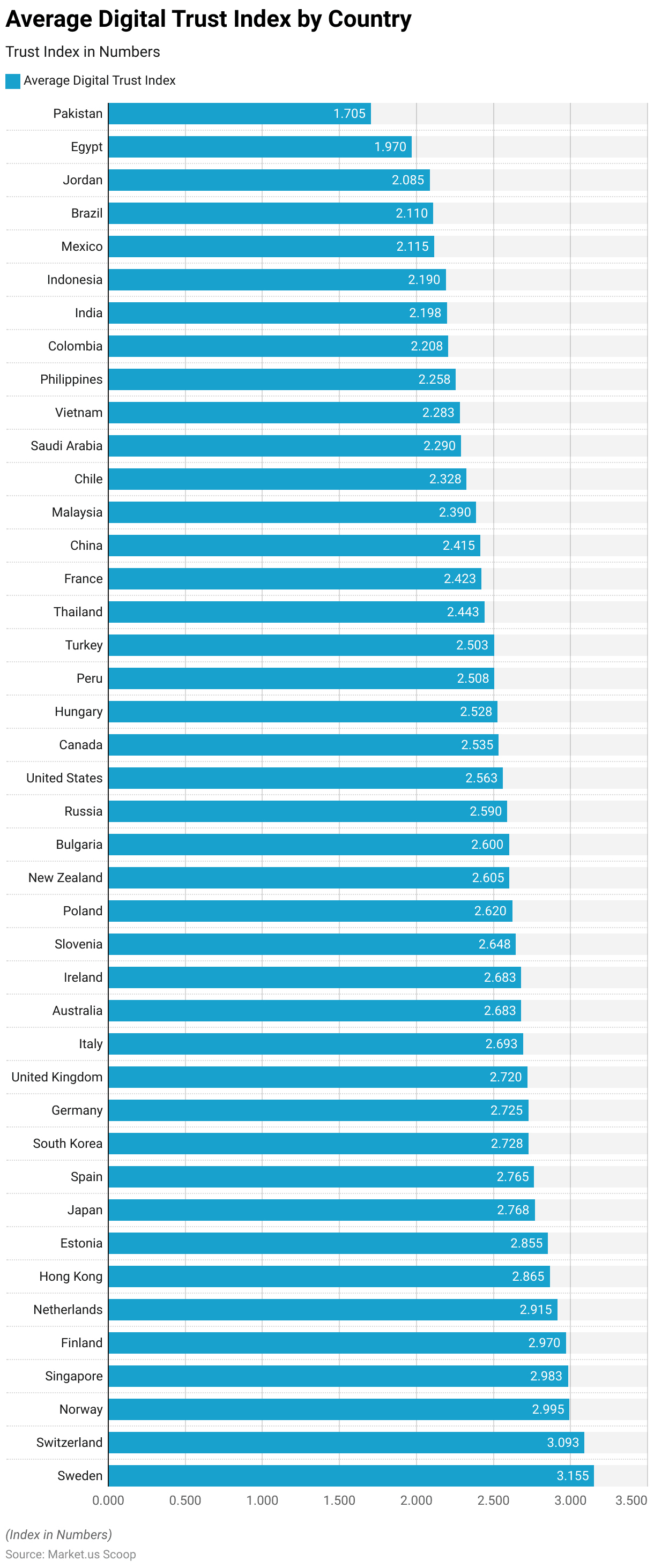
Recent Developments
Acquisitions and Mergers:
- IBM acquires ReaQta: In late 2023, IBM acquired ReaQta, a cybersecurity company specializing in endpoint security and threat detection, for $300 million. This acquisition aims to strengthen IBM’s digital trust offerings by enhancing its ability to protect client data.
- Symantec merges with Avast: In early 2024, Symantec merged with Avast, creating one of the largest cybersecurity firms. The merger, valued at $8 billion, aims to combine its strengths in digital trust, providing comprehensive security solutions for consumers and businesses.
New Product Launches:
- Microsoft Defender for Business: Microsoft launched Defender for Business in mid-2023, a cybersecurity solution tailored for small and medium-sized enterprises (SMEs). This product includes advanced threat protection and endpoint security to enhance digital trust for smaller businesses.
- Google Cloud Confidential Computing: Google introduced Confidential Computing in early 2024, a new feature on its cloud platform that encrypts data during processing, providing enhanced security and privacy for businesses handling sensitive information.
Funding:
- Palo Alto Networks raises $1 billion: Palo Alto Networks, a leader in cybersecurity, raised $1 billion in a funding round in 2023 to expand its digital trust solutions and enhance its threat detection and prevention technologies.
- OneTrust secures $300 million: OneTrust, a privacy and security management platform, secured $300 million in funding in early 2024 to develop new features and expand its global reach, focusing on helping organizations build digital trust with their customers.
Technological Advancements:
- Blockchain for Digital Identity: Advances in blockchain technology are being leveraged to create secure digital identities, enhancing trust in digital transactions by providing tamper-proof and transparent authentication processes.
- AI-Driven Threat Detection: AI and machine learning are being integrated into cybersecurity systems to improve threat detection and response times, making digital environments safer and more trustworthy.
Market Dynamics:
- Growth in Digital Trust Market: The global digital trust market is expected to grow at a CAGR of 13.8% from 2024 to 2034, driven by the increasing need for secure digital interactions and the rise in cyber threats.
- Increased Investment in Cybersecurity: Businesses are increasing their investments in cybersecurity solutions to protect their digital assets and build trust with their customers, with global cybersecurity spending projected to reach $150 billion in 2024.
Regulatory and Strategic Developments:
- EU’s Digital Services Act (DSA): The European Union implemented the Digital Services Act in 2023, which includes stringent requirements for digital platforms to enhance user privacy and security, thereby fostering digital trust.
- US Executive Order on Cybersecurity: In early 2024, the US government issued an executive order to improve national cybersecurity, focusing on enhancing digital trust through better security practices and increased transparency from tech companies.
Research and Development:
- Quantum-Resistant Encryption: Researchers are developing quantum-resistant encryption algorithms to future-proof digital security against potential threats from quantum computing, ensuring long-term digital trust.
- Behavioral Biometrics: R&D efforts are focusing on behavioral biometrics, which analyzes user behavior patterns for authentication purposes, providing a more secure and user-friendly approach to digital trust.
Conclusion
Digital Trust Statistics – In conclusion, digital trust is the cornerstone of our evolving digital landscape, profoundly influencing our online interactions and transactions.
It is the bedrock upon which e-commerce, data protection, technological advancements, and cybersecurity are built.
As we navigate an era of data breaches, privacy concerns, and the emergence of transformative technologies, trust in digital systems, services, and data is paramount.
Key components such as security, privacy, transparency, reliability, user experience, reputation, and compliance with legal and ethical standards are pivotal in nurturing trust.
The consequences of trust, or its absence, resonate in social, economic, and political realms. Fostering and maintaining digital trust is not just an ethical imperative but fundamental for a prosperous, secure, and digitally connected future.
FAQs
Digital trust is individuals, organizations, and societies’ confidence in the reliability, security, and integrity of digital systems, services, and data. It’s a fundamental concept that underpins our ability to conduct business, communicate, and share information in the digital age.
Digital trust is crucial for several reasons. It’s the foundation of e-commerce, data protection, and the adoption of emerging technologies like artificial intelligence and blockchain. It also influences our online interactions, shapes our decisions, and has far-reaching effects on social, economic, and political outcomes.
The key components of digital trust include security, privacy, transparency, reliability, user experience, reputation, and compliance with legal and ethical standards. These elements collectively contribute to fostering trust in digital systems and services.
To build and maintain digital trust, organizations should focus on implementing strong cybersecurity measures, respecting user privacy, being transparent about data practices, ensuring reliability, providing a positive user experience, building a good reputation, and adhering to legal and ethical standards.
Individuals can protect their digital trust by being cautious with their online activities, using strong and unique passwords, enabling two-factor authentication, staying informed about data privacy regulations, and discerning the sources of information and services they use online.
While digital trust and cybersecurity are related concepts, they are different. Digital trust encompasses a broader spectrum of factors, including security, privacy, transparency, and more, while cybersecurity specifically focuses on protecting digital systems and data from threats and attacks.
Discuss your needs with our analyst
Please share your requirements with more details so our analyst can check if they can solve your problem(s)



